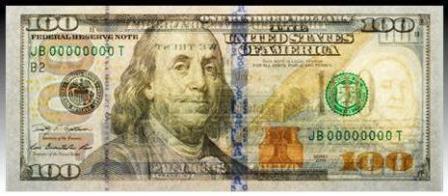New Security Design for $100 Note But 500 Euro More Favored by Terrorists, Money Launderers

Even though the Department of the Treasury unveiled a new $100 note today, Ben Franklin now takes second place to the 500 Euro. Mafia money launderers, terrorists and tax dodgers like the Euro bill because they're easy to hide and transport, the Bank of Italy said in a report. As much as 6 million euros ($8.1 million) fit in an overnight bag, and 10 million Euros in a 45-centimeter (18-inch) safe-deposit box, the central bank said in a 15-page internal study obtained by Bloomberg News.
On the home front, complete with advanced technology to
combat counterfeiting, the new design for the $100 note retains the traditional
look of U.S. currency.
"As with previous U.S. currency redesigns, this note
incorporates the best technology available to ensure we're staying ahead of
counterfeiters," said Secretary of the Treasury Tim Geithner.
"When the new design $100 note is issued on February
10, 2011, the approximately 6.5 billion older design $100s already in
circulation will remain legal tender," said Chairman of the Federal
Reserve Board Ben S. Bernanke. "U.S. currency users should know they will
not have to trade in their older design $100 notes when the new ones begin
circulating."
There are a number of security features in the redesigned
$100 note, including two new features, the 3-D Security Ribbon and the Bell in
the Inkwell. These security features are easy for consumers and merchants to
use to authenticate their currency.
The blue 3-D Security Ribbon on the front of the new $100
note contains images of bells and 100s that move and change from one to the
other as you tilt the note. The Bell in the Inkwell on the front of the note is
another new security feature. The bell changes color from copper to green when
the note is tilted, an effect that makes it seem to appear and disappear within
the copper inkwell.
"The new security features announced today come after
more than a decade of research and development to protect our currency from
counterfeiting. To ensure a seamless introduction of the new $100 note into the
financial system, we will conduct a global public education program to ensure
that users of U.S. currency are aware of the new security features," said
Treasurer of the United States Rosie Rios.
"For 145 years, the men and women of the United States
Secret Service have worked diligently to protect the integrity of U.S. currency
from counterfeiters," said Director Mark Sullivan. "During that time,
our agency has evolved to keep pace with the advanced methodologies employed by
the criminals we pursue. What has remained constant in combating
counterfeiting, however, is the effectiveness of consumer education initiatives
that urge merchants and customers to examine the security features on the notes
they receive."
Although less than 1/100th of one percent of the value of
all U.S. currency in circulation is reported counterfeit, the $100 note is the
most widely circulated and most often counterfeited denomination outside the
U.S.
"The $100 is the highest value denomination that we
issue, and it circulates broadly around the world," said Michael Lambert,
Assistant Director for Cash at the Federal Reserve Board. "Therefore, we
took the necessary time to develop advanced security features that are easy for
the public to use in everyday transactions, but difficult for counterfeiters to
replicate."
"The advanced security features we've included in the
new $100 note will hinder potential counterfeiters from producing high-quality
fakes that can deceive consumers and merchants," said Larry R. Felix,
Director of the Treasury's Bureau of Engraving and Printing. "Protect
yourself - it only takes a few seconds to check the new $100 note and know it's
real."
The new design for the $100 note retains three effective
security features from the previous design: the portrait watermark of Benjamin
Franklin, the security thread, and the color-shifting numeral 100.
The new $100 note also displays American symbols of freedom,
including phrases from the Declaration of Independence and the quill the
Founding Fathers used to sign this historic document. Both are located to the right of the portrait
on the front of the note.
The back of the note has a new vignette of Independence Hall
featuring the rear, rather than the front, of the building. Both the vignette
on the back of the note and the portrait on the front have been enlarged, and
the oval that previously appeared around both images has been removed.
Security Bloggers can visit www.newmoney.gov for information
on how to order free training materials for cash handlers, or you may download
the materials directly from the Web site. The training materials for the $100
note are available in 25 languages.